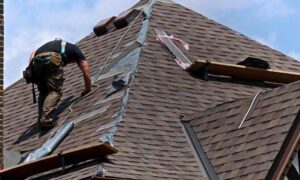Your roof is your home’s first line of defense against the elements, making seasonal maintenance essential for your roof repairs, restoration and long-term performance and safety. Each season brings its own challenges for roof repairs, from the scorching heat of summer to the heavy rains of spring. Keeping your roof in good shape all year ensures your home remains protected, your energy bills stay low, and costly roof repairs often are avoided. Below are helpful maintenance tips tailored to each season to keep your roof in excellent condition.
1. Inspect Your Roof After Winter
Winter can be harsh on roofing materials. Once the season ends, it’s wise to conduct a full inspection of any roofing contractors doing new roof, or roofing services. Look for cracked shingles, ice damage, and signs of sagging or water infiltration. These issues, if not addressed, can lead to bigger problems down the line. Scheduling a roof replacement and a professional check-up is also a smart move.
2. Clean Out Gutters and Downspouts
Leaves, twigs, and debris tend to accumulate in gutters, especially during fall and winter. If left unattended, clogged gutters can cause water to back up and damage the roof edge. Regularly cleaning them out ensures tile roof has proper drainage and reduces the risk of moisture problems. It’s best to do this at the beginning of spring and fall.
3. Look for Signs of Mold or Mildew
Moisture buildup can lead to mold and mildew growth, which weakens the roof structure and poses health risks. Check for dark stains or moss patches, especially on shaded roof areas. Removing these early with proper cleaning solutions will preserve the roof’s integrity and appearance. Prevention is much cheaper than treatment.
4. Trim Overhanging Tree Branches
Trees can be a major hazard if branches hang too close to the roof. During storms or windy conditions, branches may scrape the surface range of roof, or fall and cause damage. Trimming back any limbs will not only protect the roof but also reduce the amount of organic debris that accumulates on existing roof. This simple task can significantly prolong roof life.
5. Check for Damaged or Missing Shingles
Shingles are your roof’s protective barrier, so any that are curled, cracked, or missing must be replaced immediately. Damaged roof and shingles compromise the roof’s ability to keep moisture out, potentially leading to interior leaks. Perform a visual inspection from the ground using binoculars, or have a contractor inspect your house and property safely.
6. Inspect Flashing Around Vents and Chimneys
Flashing seals the gaps around vents, chimneys, and skylights, preventing leaks. Over time, flashing can warp, rust, or come loose, especially during repairs or seasonal transitions. Carefully check these areas for signs of wear and reseal if necessary. Proper flashing maintenance keeps water from seeping into the attic or walls.
7. Look Inside Your Attic
Sometimes roof problems start inside the roofing industry home. Peek into your roof or attic periodically to check for signs of leaks, moisture, or light coming through the roof boards. Wet insulation or musty odors from new roof can indicate a leak. Early detection and the roof repairs Brisbane can save thousands in water damage and roof repairs.
8. Prepare for Heavy Rains
In preparation for rainy seasons, ensure that all drainage components are working properly. Check that gutters are secure and not sagging, and that downspouts are directing water away from the foundation. Inspect valleys where water naturally flows to ensure they’re clear and undamaged. Small adjustments here can prevent flooding.
9. Reinforce Roof Seals Before Storms
Before hurricane or storm season begins, inspect the seals around vents, skylights tile roof top, and flashing. High winds and heavy rains can exploit even the smallest gaps. Resealing or reinforcing these areas will add another layer of protection. Investing time in this now prevents emergency repairs later.
10. Perform a Spring Deep Clean
Spring is a great time to remove accumulated debris, dirt, and algae from your roof. Use a soft-bristled brush or a low-pressure washer if needed, being careful not to damage shingles. A clean roof not only looks better but also functions more efficiently. It’s also a good time for professional maintenance and repair services.
11. Check for Animal Activity
Small animals like birds, squirrels, and raccoons can cause hidden roof damage by nesting or chewing through materials. Look for droppings, nests, or unusual sounds near the house or roofline. Addressing these signs early helps avoid structural damage and potential infestations. Regular monitoring is key.
12. Apply Roof Coating in Summer
Summer is an ideal time to apply protective coatings to your roof restoration prolong your roof’s life. A reflective coating can also help reduce heat absorption, lowering cooling costs. Make sure the weather is dry and the surface is clean before applying. This seasonal prep adds energy efficiency and protection to existing roofing companies and few Brisbane roofing companies too.
13. Schedule a Professional Inspection
Even if your roof appears to be in good condition, a professional inspection at least once a year is highly recommended. Experts can spot any repairs and early warning signs that homeowners often overlook. This due process is especially useful if you live in a region known for harsh weather changes. Roof repairs Brisbane comprehensive roof repair services are available for residents needing expert support.
14. Monitor for Sagging or Structural Shifts
Over time, a used metal roofing can may sag due to water damage or compromised framing. Look for areas of metal roofing that appear lower or uneven, particularly after snow or rainstorms. If caught early, structural repairs can be localized and less expensive. Ignoring sagging roof above can lead to dangerous collapses.
15. Reassess Roof Ventilation
Good airflow through your attic helps regulate temperature and moisture, extending your roof’s life. Check that vents are not blocked by insulation or debris. Poor ventilation can lead to mold growth, higher utility bills, and shingle deterioration. This is a critical step many homeowners overlook.
16. Plan for Roof Replacement if Necessary
Roofs don’t last forever. If yours is 20 years or older, it might be time to start planning for a full roof replacement. Watch for widespread shingle loss, granule buildup in gutters, and persistent leaks. A proactive approach to roof replacement gives you time to budget and choose quality materials before an emergency arises.
Taking care of your roof doesn’t have to be overwhelming. By breaking it down into seasonal maintenance tasks, you can ensure year-round protection and performance. Staying vigilant and addressing issues early will keep your home safe and save you money in the long run. With these tips, you’ll be ready no matter what the weather brings.



































